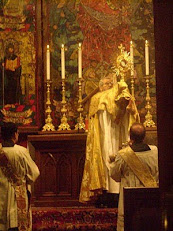by Robert Hiini
A great deal of natural curiosity surrounding the Anglican ordinariate has been answered with the publication of A little Catechism on the Personal Ordinariates for former Anglicans authored by Melbourne Bishop Peter Elliott, a former Anglican. Not only does the small tome answer the question of what the ordinariate is and can do, but also questions about who is able to join, whether ordinariate priests must be celibates and how ordinariate worship might be different to that in Western and Eastern Catholic churches.
Australia’s Personal Ordinariate of Our Lady of the Southern Cross came into being on June 15, 2012 and is one of three ordinariates established for former Anglicans throughout the world, along with those in England and the United States...
Read the full story at the web site of The Record.
Obituary of a very failed Pontificate
-
"Nun khre methusthen kai tina per bian ponen, epei de katthane
Mursilos."Such would have been the reaction of the unchristianised Greeks.
But for us, for t...
2 months ago















“Cradle Catholics” who do not have a very close family member in the ordinariate, cannot become registered members but are free to take part in the worship, sacraments and pastoral life of ordinariate parishes, just as they might in Eastern Rite Catholic churches.
ReplyDeleteNow let me see!. Many may be "Cradle Catholics", because of the changes made after Vatican 2 to the Ordinary Form of the Roman Rite. So "Cradle Catholics" cannot be part of the Ordinariate. But can only be part of the Roman Rite, for which they left in the first place. A Novus Ordo Church, with happy clappy liberally minded Roman Catholics, who would rather worship like Evangelical Lutherans, than orthodox traditional Christians. Seems like a bad decision to me!!. Guess I might have to join one of the Byzantine Rite parishes, and ask for a change of rite. Since I will not be given that option in the Roman Rite/Ordinariate.
Robert, were an ordinariate parish near enough, you would be able, for all practical purposes, to be a member of the parish; taking part in the worship, fellowship, good works, etc. This is what I do at the Anglican Use parish of St. Athanasius, and I am not the only one at our parish in this situation. The only time such a "cradle Catholic" might need to have recourse to their geographical Roman Rite parish is if he were seeking to get married or ordained to the diaconate or priesthood. The only barrier that they might face in an Ordinariate parish is they wouldn't be eligible to be on the pastoral or finance councils (I assume those will be limited to members, but the Particular Norms, which have been approved, have not been published for public viewing yet).
ReplyDeleteMembers of the Ordinariate are in a situation of dual membership; they are part of the diocese in which they live in (the particular church into which they are received via the sacraments of initiation) and they are members of the ordinariate (which is by achieved by written application, not sacramentally). Non-members of the Ordinariate, while they are not in the register of the Ordinariate, can nevertheless take part in the worship of these fellow Catholics and support the parish in any way they are able.
Thanks!. I didn't know that you could be part of the parish.
ReplyDelete